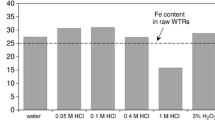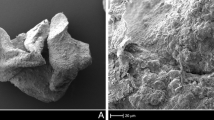Abstract
A high-performance sorbent, modified water treatment residuals–sodium alginate beads (WTR-SA beads), was prepared through a series of salt and combined thermal roasting composite modification between water treatment residuals and sodium alginate. The properties of modified WTR-SA beads composites were characterized by SEM–EDS, FT-IR, XRD, and BET. The adsorption performance of WTR-SA beads was investigated in removing nitrogen and phosphorus from wastewater. Compared to the unmodified WTR, the removal efficiency of nitrogen and phosphorus onto the modified WTR-SA beads was increased from 22.34 and 77.13% to 95.14 and 98.31%, respectively. The adsorption capacities of nitrogen and phosphorus onto the modified WTR-SA beads were reach a maximum of 2.52 mg/g and 6.45 mg/g, respectively. The adsorption behavior can be well described using a quasi-second-order kinetic model and Langmuir isotherm model. The thermodynamic properties of nitrogen adsorption indicated that the adsorption was spontaneous and exothermic. On the contrary, the adsorption process of phosphorus is an endothermic reaction. The adsorption of nitrogen by modified WTR-SA beads is mainly carried out through ion exchange and hydroxyl complexation, and ion exchange plays a major role in it. While, the adsorption of modified WTR-SA beads on phosphorus is affected by three actions: ligand exchange, chemical precipitation, and ion exchange, which ligand exchange is the main effect. Based on these results, it can be concluded that the modified WTR-SA beads are a high efficiency adsorbent for removing nitrogen and phosphorus from domestic and industrial wastewater.











Similar content being viewed by others
References
Babatunde A, Zhao Y (2007) Constructive approaches toward water treatment works sludge management: an international review of beneficial reuses. Crit Rev Environ Sci Technol 37:129–164. https://doi.org/10.1080/10643380600776239
Bai L, Wang C, Zhao J (2014) Reuse of drinking water treatment residuals in continuous stirred tank reactor for phosphate removal from urban wastewater. Environ Technol 35:2752–2759. https://doi.org/10.1080/09593330.2014.920050
Bhatnagar A, Kumar E, Sillanpää M (2010) Nitrate removal from water by nano-alumina: characterization and sorption studies. Chem Eng J 163:317–323. https://doi.org/10.1016/j.cej.2010.08.008
Blaney LM, Cinar S, SenGupta AK (2007) Hybrid anion exchanger for trace phosphate removal from water and wastewater. Water Res 41:1603–1613. https://doi.org/10.1016/j.watres.2007.01.008
Chojnacka K (2005) Equilibrium and kinetic modelling of chromium(III) sorption by animal bones. Chemosphere 59:315–320. https://doi.org/10.1016/j.chemosphere.2004.10.052
Cockburn A, Heppner CW, Dorne JLCM (2014) Environmental contaminants: nitrate and nitrite. Encyclopedia Food Safety 2:332–336. https://doi.org/10.1016/B978-0-12-378612-8.00199-2
Duan J-MLJ-M, Fang H-D, Lin J-Q, Lin S-M (2012) Adsorption characteristic of modified steel-making slag for simultaneous removal of phosphorus and ammonium nitrogen from aqueous solution. J Environ Eng 6:201–205
Ghiaci M, Abbaspur A, Kia R, Seyedeyn-Azad F (2004) Equilibrium isotherm studies for the sorption of benzene, toluene, and phenol onto organo-zeolites and as-synthesized MCM-41. Sep Purif Technol 40:217–229. https://doi.org/10.1016/j.seppur.2004.03.001
Ho YS, McKay G (1999) A kinetic study of dye sorption by biosorbent waste product pith. Resour Conserv Recycl 25:171–193. https://doi.org/10.1016/S0921-3449(98)00053-6
Huang H, Xiao X, Yan B, Yang L (2010) Ammonium removal from aqueous solutions by using natural Chinese (Chende) zeolite as adsorbent. J Hazard Mater 175:247–252. https://doi.org/10.1016/j.jhazmat.2009.09.156
Huang T, Yan M, He K, Huang Z, Zeng G, Chen A, Peng M, Li H, Yuan L, Chen G (2019) Efficient removal of methylene blue from aqueous solutions using magnetic graphene oxide modified zeolite. J Colloid Interface Sci 543:543–551. https://doi.org/10.1016/j.jcis.2019.02.030
Igor Ž et al (2019) Relations between mercury fractions and microbial community components in seawater under the presence and absence of probable phosphorus limitation conditions. J Environ Sci 31:145–162
Ji J, Peng Y, Wang B, Li X, Zhang Q (2020) A novel SNPR process for advanced nitrogen and phosphorus removal from mainstream wastewater based on anammox, endogenous partial-denitrification and denitrifying dephosphatation. Water Res 170:115363. https://doi.org/10.1016/j.watres.2019.115363
Jiang Y-H, Li A-Y, Deng H, Ye C-H, Wu Y-Q, Linmu Y-D, Hang H-L (2019) Characteristics of nitrogen and phosphorus adsorption by Mg-loaded biochar from different feedstocks. Bioresour Technol 276:183–189. https://doi.org/10.1016/j.biortech.2018.12.079
Karadag D, Koc Y, Turan M, Armagan B (2006) Removal of ammonium ion from aqueous solution using natural Turkish clinoptilolite. J Hazard Mater 136:604–609. https://doi.org/10.1016/j.jhazmat.2005.12.042
Keeley J, Smith AD, Judd SJ, Jarvis P (2014) Reuse of recovered coagulants in water treatment: an investigation on the effect coagulant purity has on treatment performance. Sep Purif Technol 131:69–78. https://doi.org/10.1016/j.seppur.2014.04.033
Lei L, Li X, Zhang X (2008) Ammonium removal from aqueous solutions using microwave-treated natural Chinese zeolite. Sep Purif Technol 58:359–366. https://doi.org/10.1016/j.seppur.2007.05.008
Li S-X, Liu F-J, Zheng F-Y, Zuo Y-G, Huang X-G (2013a) Effects of nitrate addition and iron speciation on trace element transfer in coastal food webs under phosphate and iron enrichment. Chemosphere 91:1486–1494. https://doi.org/10.1016/j.chemosphere.2012.12.018
Li X et al (2019) A novel red mud adsorbent for phosphorus and diclofenac removal from wastewater. J Mol Liq 112286. https://doi.org/10.1016/j.molliq.2019.112286
Li Z, Jiang N, Wu F, Zhou Z (2013b) Experimental investigation of phosphorus adsorption capacity of the waterworks sludges from five cities in China. Ecol Eng 53:165–172. https://doi.org/10.1016/j.ecoleng.2012.12.038
Liu S, Daigger GT, Liu B, Zhao W, Liu J (2020) Enhanced performance of simultaneous carbon, nitrogen and phosphorus removal from municipal wastewater in an anaerobic-aerobic-anoxic sequencing batch reactor (AOA-SBR) system by alternating the cycle times. Bioresour Technol:122750. https://doi.org/10.1016/j.biortech.2020.122750
Liu T, Chen X, Wang X, Zheng S, Yang L (2018) Highly effective wastewater phosphorus removal by phosphorus accumulating organism combined with magnetic sorbent MFC@La(OH)3. Chem Eng J 335:443–449. https://doi.org/10.1016/j.cej.2017.10.117
Mazloomi F, Jalali M (2016) Ammonium removal from aqueous solutions by natural Iranian zeolite in the presence of organic acids, cations and anions. J Environ Chem Eng 4:240–249. https://doi.org/10.1016/j.jece.2015.11.001
Min P et al (2018) Superhydrophobic kaolinite modified graphene oxide-melamine sponge with excellent properties for oil-water separation. Appl Clay Sci 163:63–71
Mortula MM, Gagnon GA (2007) Alum residuals as a low technology for phosphorus removal from aquaculture processing water. Aquac Eng 36:233–238. https://doi.org/10.1016/j.aquaeng.2006.12.003
Okada K et al (2013) Association between higher glucose variability, determined by continuous glucose monitoring system, and poor clinical characteristics in stemi patients with dysglycemia, in comparison with conventional glycemic parameters. J Am Coll Cardiol 61:E93. https://doi.org/10.1016/S0735-1097(13)60094-7
Özacar M (2003) Adsorption of phosphate from aqueous solution onto alunite. Chemosphere 51:321–327. https://doi.org/10.1016/S0045-6535(02)00847-0
Park H-J, Na C-K (2006) Preparation of anion exchanger by amination of acrylic acid grafted polypropylene nonwoven fiber and its ion-exchange property. J Colloid Interface Sci 301:46–54. https://doi.org/10.1016/j.jcis.2006.05.003
Pitakpoolsil W, Hunsom M (2014) Treatment of biodiesel wastewater by adsorption with commercial chitosan flakes: parameter optimization and process kinetics. J Environ Manag 133:284–292. https://doi.org/10.1016/j.jenvman.2013.12.019
Prochaska CA, Zouboulis AI (2006) Removal of phosphates by pilot vertical-flow constructed wetlands using a mixture of sand and dolomite as substrate. Ecol Eng 26:293–303. https://doi.org/10.1016/j.ecoleng.2005.10.009
Rauf MA, Bukallah SB, Hamour FA, Nasir AS (2008) Adsorption of dyes from aqueous solutions onto sand and their kinetic behavior. Chem Eng J 137:238–243. https://doi.org/10.1016/j.cej.2007.04.025
Ricardo AR, Carvalho G, Velizarov S, Crespo JG, Reis MAM (2012) Kinetics of nitrate and perchlorate removal and biofilm stratification in an ion exchange membrane bioreactor. Water Res 46:4556–4568. https://doi.org/10.1016/j.watres.2012.05.045
Saltalı K, Sarı A, Aydın M (2007) Removal of ammonium ion from aqueous solution by natural Turkish (Yıldızeli) zeolite for environmental quality. J Hazard Mater 141:258–263. https://doi.org/10.1016/j.jhazmat.2006.06.124
Samatya S, Kabay N, Yüksel Ü, Arda M, Yüksel M (2006) Removal of nitrate from aqueous solution by nitrate selective ion exchange resins. React Funct Polym 66:1206–1214. https://doi.org/10.1016/j.reactfunctpolym.2006.03.009
Schoeman JJ, Steyn A (2003) Nitrate removal with reverse osmosis in a rural area in South Africa. Desalination 155:15–26. https://doi.org/10.1016/S0011-9164(03)00235-2
Shuoxun D, Qinghua J, Yili W, Huijuan L, Jiuhui Q (2020) Enhanced phosphate removal using zirconium hydroxide encapsulated in quaternized cellulose. J Environ Sci 32:102–112
Sudiarto SIA, Renggaman A, Choi HL (2019) Floating aquatic plants for total nitrogen and phosphorus removal from treated swine wastewater and their biomass characteristics. J Environ Manag 231:763–769. https://doi.org/10.1016/j.jenvman.2018.10.070
Tang C-C, Tian Y, Liang H, Zuo W, Wang Z-W, Zhang J, He Z-W (2018) Enhanced nitrogen and phosphorus removal from domestic wastewater via algae-assisted sequencing batch biofilm reactor. Bioresour Technol 250:185–190. https://doi.org/10.1016/j.biortech.2017.11.028
Tedd KM, Coxon CE, Misstear BDR, Daly D, Craig M, Mannix A, Williams NHH (2014) An integrated pressure and pathway approach to the spatial analysis of groundwater nitrate: a case study from the southeast of Ireland. Sci Total Environ 476-477:460–476. https://doi.org/10.1016/j.scitotenv.2013.12.085
Titshall L, Hughes J, Bester H (2013) Characterisation of alkaline tailings from a lead/zinc mine in South Africa and evaluation of their revegetation potential using five indigenous grass species. South Afr J Plant Soil 30:97–105. https://doi.org/10.1080/02571862.2013.807361
van Dijk HWJ, de Groot WT (1987) Eutrophication of a coastal dune area by artificial infiltration. Water Res 21:11–18. https://doi.org/10.1016/0043-1354(87)90093-5
Wan C, Ding S, Zhang C, Tan X, Zou W, Liu X, Yang X (2017) Simultaneous recovery of nitrogen and phosphorus from sludge fermentation liquid by zeolite adsorption: mechanism and application. Sep Purif Technol 180:1–12. https://doi.org/10.1016/j.seppur.2017.02.031
Wang C, Zhao Y (2015) Comparison of metal lability in air-dried and fresh dewatered drinking water treatment residuals. J Environ Sci Health 50:135–143. https://doi.org/10.1080/10934529.2015.975054
Wang Y, Yu Y, Li H, Shen C (2016) Comparison study of phosphorus adsorption on different waste solids: fly ash, red mud and ferric–alum water treatment residues. J Environ Sci 50:79–86. https://doi.org/10.1016/j.jes.2016.04.025
Wei X, Viadero RC, Bhojappa S (2008) Phosphorus removal by acid mine drainage sludge from secondary effluents of municipal wastewater treatment plants. Water Res 42:3275–3284. https://doi.org/10.1016/j.watres.2008.04.005
Xu GR, Li GB (2009) Ceramsite obtained from water and wastewater sludge and its characteristics affected by (Fe(2)O(3) + CaO + MgO)/(SiO(2) + Al(2)O(3)). Water Res 43:2885–2893. https://doi.org/10.1016/j.watres.2009.03.046
Yan J, Jiang T, Yao Y, Lu S, Wang Q, Wei S (2016) Preliminary investigation of phosphorus adsorption onto two types of iron oxide-organic matter complexes. J Environ Sci 42:152–162. https://doi.org/10.1016/j.jes.2015.08.008
Yang Y, Zhao YQ, Babatunde AO, Wang L, Ren YX, Han Y (2006) Characteristics and mechanisms of phosphate adsorption on dewatered alum sludge. Sep Purif Technol 51:193–200. https://doi.org/10.1016/j.seppur.2006.01.013
Zhang Q et al (2013) Selective removal of phosphate in waters using a novel of cation adsorbent: Zirconium phosphate (ZrP) behavior and mechanism. Chem Eng J 221:315–321. https://doi.org/10.1016/j.cej.2013.02.001
Zhang Y, Bi E (2012) Effect of dissolved organic matter on ammonium sorption kinetics and equilibrium to Chinese clinoptilolite. Environ Technol 33:2395–2403. https://doi.org/10.1080/09593330.2012.670268
Zhengchi Y, Lihua L, Lu Z, Gang S, Zuoxiao W, Anping T, Jianrong X (2019) Preparation and evaluation of bis(diallyl alkyl tertiary ammonium salt) polymer as a promising adsorbent for phosphorus removal. J Environ Sci 31:24–37
Zhou L, Boyd CE (2014) Total ammonia nitrogen removal from aqueous solutions by the natural zeolite, mordenite: a laboratory test and experimental study. Aquaculture 432:252–257. https://doi.org/10.1016/j.aquaculture.2014.05.019
Acknowledgements
Thanks to Chen Chongyu for completing part of the experimental operation.
Funding
The study was financially supported by the Key R&D Program of Hunan Provincial (2018SK2013, 2018SK2023).
Author information
Authors and Affiliations
Contributions
Guangyi Fu and Yuanyuan Zhao contributed the central idea, analyzed most of the data, and wrote the initial draft of the paper. Chongyu Chen and Shuang Zhou are responsible for the operation of the experiment and the writing of the manuscript. Youze Xu and Yu Zhong are responsible for the review of the manuscript.
Corresponding authors
Ethics declarations
Ethical approval
Ethics approval was not required for this research
Conflict of interest
The authors declare that they have no conflict of interest.
Additional information
Responsible Editor: Angeles Blanco
Publisher’s note
Springer Nature remains neutral with regard to jurisdictional claims in published maps and institutional affiliations.
Rights and permissions
About this article
Cite this article
Fu, G., Zhao, Y., Zhou, S. et al. Efficient removal of nitrogen and phosphorus in aqueous solutions using modified water treatment residuals–sodium alginate beads. Environ Sci Pollut Res 28, 46233–46246 (2021). https://doi.org/10.1007/s11356-021-12586-6
Received:
Accepted:
Published:
Issue Date:
DOI: https://doi.org/10.1007/s11356-021-12586-6




